Professional Grade: CMYK and PMS In Practical Terms
Learn the basics and its relevance to your next printing project.
BY FOLDERPRINTERS WRITERS
Posted on 5/16/2023
Tags: Information
In the lexicon of professional commercial printing, CMYK and PMS are terms that you encounter. What do these mean
and why do they matter? This article will discuss the significance of these acronyms and how they are relevant, in
practical terms, to your printing project.
Both terms are to do with color, each with a specific and unique application in the printing process.
CMYK
The letters in CMYK stand for Cyan, Magenta, Yellow, and Black (the letter K taken from “Key,” as in
“Key Color” or “Key Plate,” which uses black ink). These are the primary colors in the CMYK
subtractive color model (for a technical explanation of subtractive colors, you can read
this online entry), which happens to be
the dominant printing process in modern commercial printing.
In simple terms, cyan, magenta, yellow and black are methodically mixed by printing each color in dots of varying
sizes and frequency (the composition of which is a method called
halftoning or screening) to create a composite image that
is a reproduction of text, illustration or photograph.
To a certain extent, it is comparable to
pointillism, the artistic technique
made famous by French post-Impressionist artist Georges Seurat, in which small, distinct dots of paint are applied
in patterns on a medium such as canvas to compose and form an image.
This process is also referred to as full-color or, because of the number of primary ink colors used, four-color
printing. Which is why you will often come across printing project specifications written in the following formats:
"
4/0 (full color printing on one side of the paper; no printing on the other)
presentation folders", and "
4/4 (full color printing on
both sides of the paper)
postcards."
Although four color
printing is now the dominant process, there was a time when it was considered a luxury — which may still hold
true for large quantity runs due to the massive offset lithography machines and ink used — but owing to great
advancements in digital printing technology, this no longer holds true, particulary in the lower quantity (less than
1,000) runs.
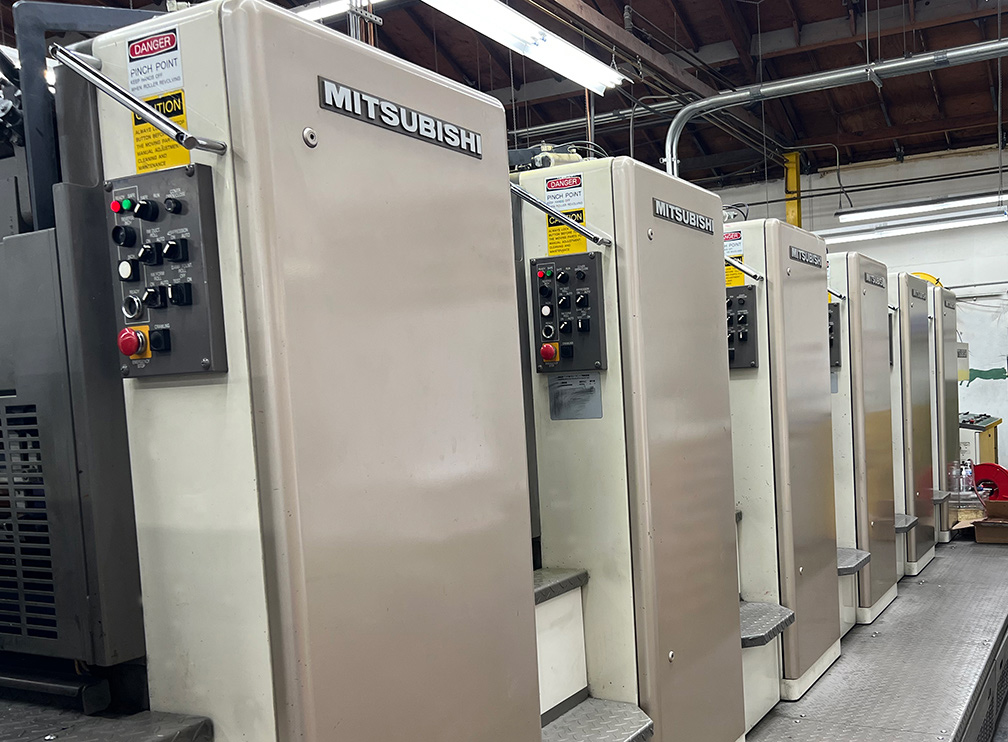 A full-color offset press. Each of the towers is for every one of the CMYK inks. Notice that this model has two
more towers for extra custom colors. This massive machine is about seven feet high and 50 feet long.
A full-color offset press. Each of the towers is for every one of the CMYK inks. Notice that this model has two
more towers for extra custom colors. This massive machine is about seven feet high and 50 feet long.
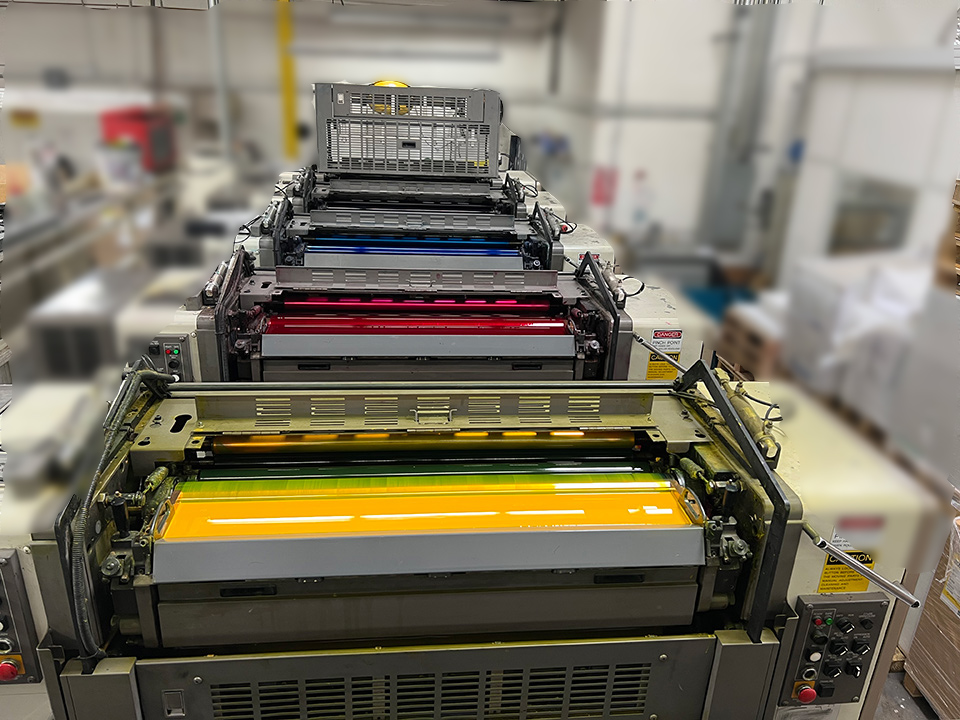 View from the top of the full-color offset machines showing the individual CMYK ink bays and rollers.
View from the top of the full-color offset machines showing the individual CMYK ink bays and rollers.
Until the late 2000s, offset litho was the preeminent printing technology, within which there existed a segmention
of equipment according to size, color and quantity capacity.
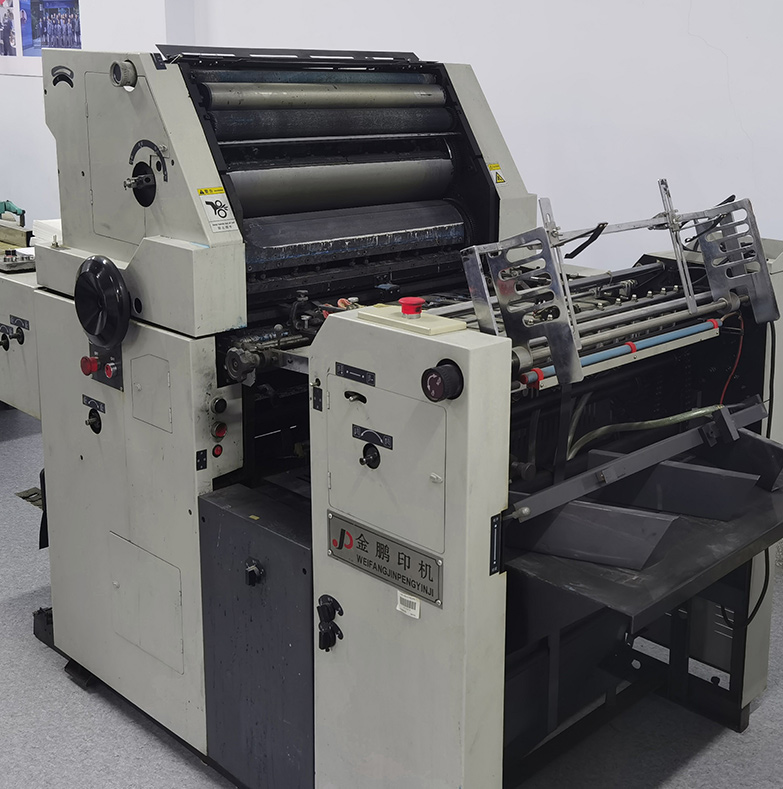 An old one-color offset press. This machine is almost 1/10th the size of the full-color offset press
shown above.
An old one-color offset press. This machine is almost 1/10th the size of the full-color offset press
shown above.
Printing companies would have gigantic 40-inch multi-color presses (with their ink and plate towers for each of the
CMYK colors) that were designed for job quantities that were in the thousands. This made them economically
impractical to use for, say, 500 flyers.
Unless the customer was willing to pay for the exorbitant cost, the option was to print in one or at most, two
colors. Color configurations for which printers also had smaller machines that were appropriately designed and
built.
During the early years of its introduction to the professional printing industry about two decades ago, the knock on
digital printing was poor image sharpness, color density and vividness. That was then. Today's latest digital
presses produce images that can rival (some would even say surpass) those of traditional offset printing. Mainly,
because digital presses do not need plates and require fewer procedures to operate compared to offset machines, it
has changed the economic model for printing in lower quantities, to the extent that full color projects have become
quite affordable, and indeed, makes more sense than printing one-color, assuming the single color is one of or the
result of a combination of CMYK.
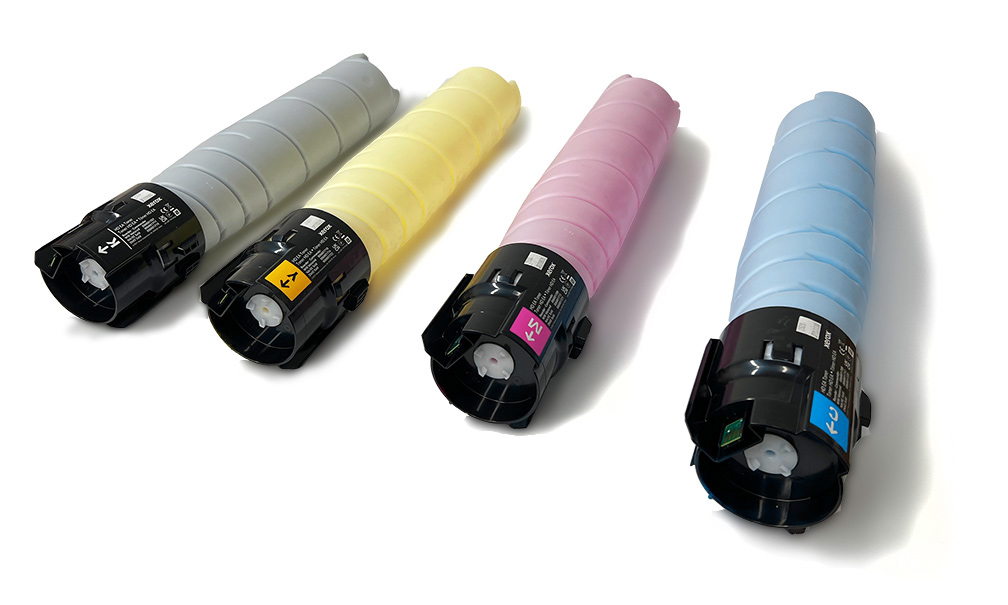 CMYK toners that go in the digital press below.
CMYK toners that go in the digital press below.
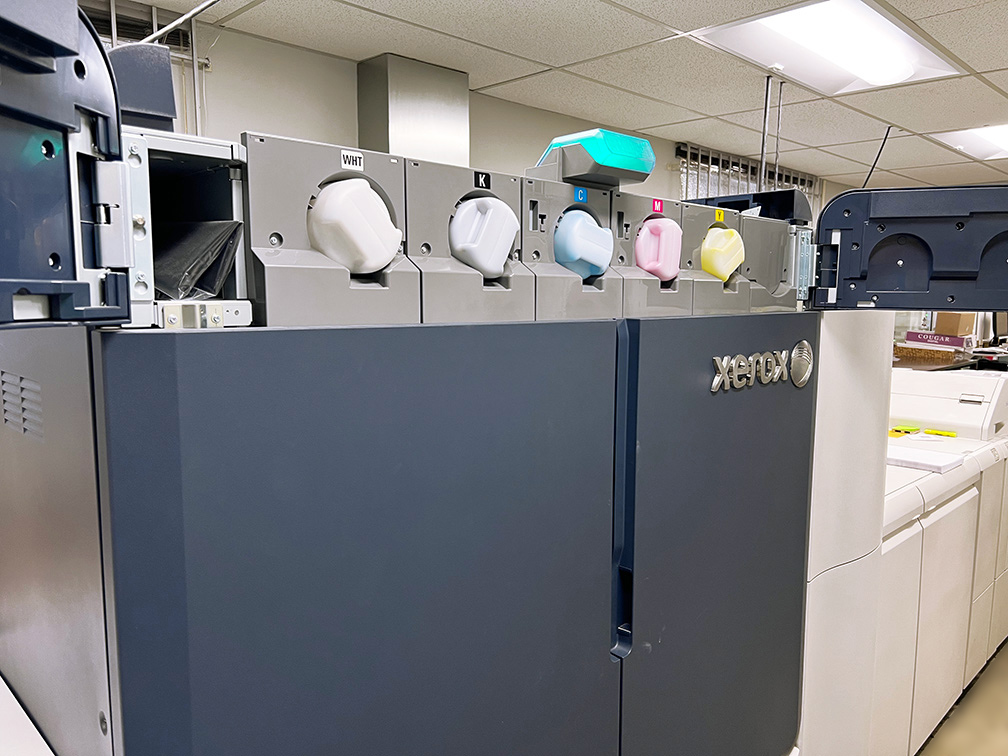 A modern late-model full color digital press. Notice that the CMYK toners are inserted in slots located in the
upper section.
A modern late-model full color digital press. Notice that the CMYK toners are inserted in slots located in the
upper section.
The qualifying assumption at the end of the previous paragraph is critical. Normally, the term "one color"
means the use of one ink color from among CMYK; however, there are situations that specify the use of an ink color
that is not one of CMYK. Enter our second acronym: PMS.
PMS
PMS stands for Pantone Matching System, a standardized color matching system developed by Pantone LLC. in which
there are over 1,000 standardized colors, each assigned a unique identifying PMS number, which makes it easy to
clearly specify a particular color.
PMS is about precision. Unlike CMYK printing which produces images by combining the four colors printed in tiny
dots, printing PMS uses ink that is pre-mixed (to a color based on formulas found on Pantone's list). It is
almost always applied in a solid pattern (as opposed to dots, although technically you could but there are extremely
few practical reasons to do so). For this reason —as well as sometimes being an add-on isolated element within
a CMYK image — it is also called a spot color.
Because the inks are pre-mixed, the PMS-colored element will consistently appear as it was intended, across all the
printed sheets. The value of this level of precision is highly evident in instances in which a color — a
specific color — cannot be compromised. The most common of these instances involves branding, where a color is
critical to the identity, character and reputation of an organization or individual.
Perhaps no other color is as inextricability associated with a brand as the "light medium robin egg blue"
is to Tiffany & Co. Indeed, only one company comes to mind upon seeing that iconic blue box. The blue, has in
fact, come to be known as Tiffany Blue.
So protective is Tiffany & Co. of this part of its identity that it has registered the Tiffany Blue color as a
color trademark. Pantone produces it as a private custom color and has designated it PMS 1837, the number deriving
from the year of Tiffany's foundation.
Another reason to use PMS is in designs that have metallic elements. While CMYK can be used to "cheat" and
simulate the metallic effect, it can never have the right sheen. Metallic Inks actually have metal particles in
them, and are not merely trying to mimic the sheen and sparkle of metal. Foil stamping is an option but is very
expensive. This leaves PMS meatllic ink as the best economic choice.
On a personal level, one possible application of this color precision would be wedding stationery, in which the
wedding party might have a strong personal connection with a very speciic color. Because wedding invitations are
most often highly customized, and in many cases produced artisanally with use the leterpresses, it would be
reasonable to print in PMS.
While each printing job is in itself a custom project, using PMS ink adds an extra level of customization, making it
ultra-bespoke, if you will. Therefore incurring extra cost.
This is mainly due to the fact that, as previously mentioned, CMYK is the now the standard professional printing
process, which means that most presses are set up with those four colors, and the use of a custom color outside of
CMYK will alter a printer's production flow and set up. Furthermore, the custom ink needs to be mixed or
purchased, and will only be used by the printer (at least for the foreseeable future, unless by some stroke of luck
another customer asks for it) for that specific job.
To be sure, PMS colors have their CMYK simulation counterparts. That is to say, a formulaic combination of the four
colors is employed to try and mimic the solid PMS color. But this is just an approximation and almost never appears
close to the actual solid PMS color.
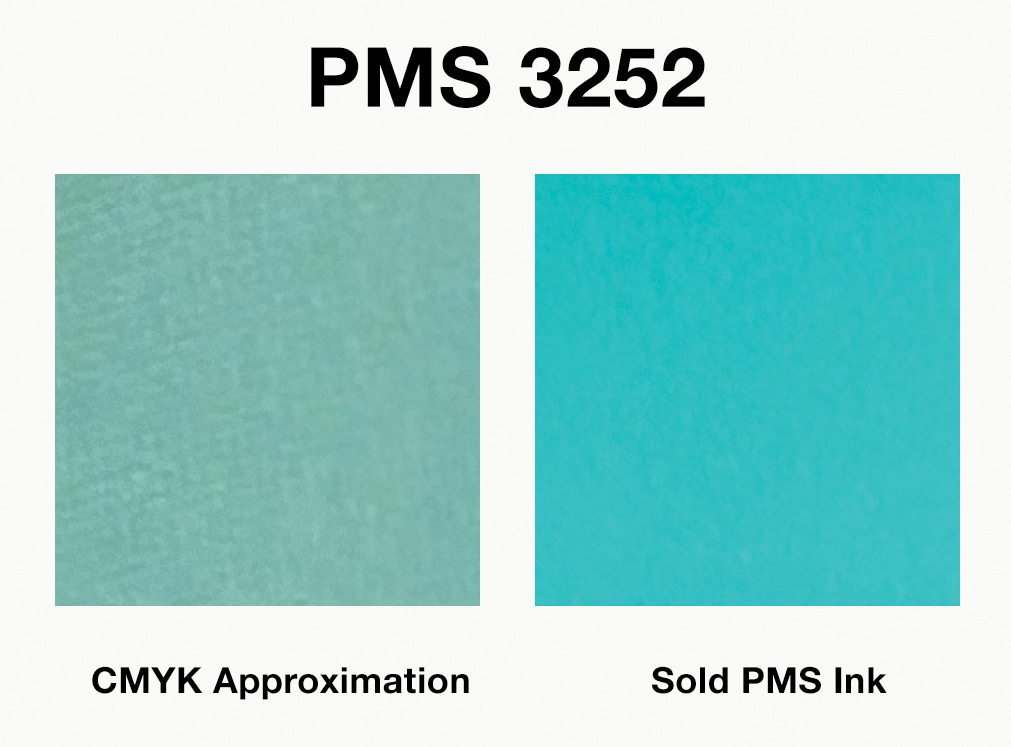 PMS 3252 (right) is near the color range of Tiffany Blue. If Tiffany & Co. were too skimp on printing PMS
and resorted instead to its CMYK equivalent (left) it would almost certainly hurt its image.
PMS 3252 (right) is near the color range of Tiffany Blue. If Tiffany & Co. were too skimp on printing PMS
and resorted instead to its CMYK equivalent (left) it would almost certainly hurt its image.
CONCLUSION
Just as it is in any service that you procure, it is good to have a basic idea of the processes involved, even if
you will never perform any part of it yourself. What’s more important is how you will use the service and
maximize the benefit of your expense. Like most industries, “digitization” has had a profound impact on
the printing industry. One of which has resulted in the “standardization” of full-color printing. As a
printing buyer, you no longer have to fear jargon like CMYK; the choice to go with full-color has become less
daunting and expensive. As marketer, you can now go toe-to-toe in print quality with the competition. But the wide
availability of full-color printing means that your competition can also afford it. To separate yourself, one option
would be the use of PMS colors.